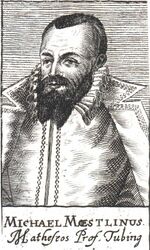Biography:Michael Maestlin
Michael Maestlin (also Mästlin, Möstlin, or Moestlin) (30 September 1550, Göppingen – 20 October 1631, Tübingen) was a Germany astronomer and mathematician, known for being the mentor of Johannes Kepler.
Career
Maestlin studied theology, mathematics, and astronomy/astrology at the University of Tübingen—the Tübinger Stift. (Tübingen was part of the Duchy of Württemberg.) He graduated as magister in 1571 and became in 1576 a Lutheran deacon in Backnang, continuing his studies there.
In 1580 he became a professor of mathematics, first at the University of Heidelberg, then at the University of Tübingen, where he taught for 47 years from 1583. In 1582 Maestlin wrote a popular introduction to astronomy.
Among his students was Johannes Kepler (1571-1630).[1] Although he primarily taught the traditional geocentric Ptolemaic view of the solar system, Maestlin was also one of the first to accept and teach the heliocentric Copernican view.[1] Maestlin corresponded with Kepler frequently and played a sizable part in his adoption of the Copernican system. Galileo Galilei's adoption of heliocentrism was also attributed to Maestlin.[2]
The first known calculation [3] of the (inverse) golden ratio as a decimal of "about 0.6180340" was written in 1597 by Maestlin in a letter to Kepler.
Notable astronomical observations
- Catalogued the Pleiades cluster on 24 December 1579. Eleven stars in the cluster were recorded by Maestlin, and possibly as many as fourteen were observed.[4]
- Occultation of Mars by Venus on 13 October 1590, seen by Maestlin at Heidelberg.[5]
Legacy
- Asteroid 11771 Maestlin, discovered in 1973
- Lunar Crater: Maestlin
- Lunar Rille: Rimae Maestlin
In Jules Verne's Cinq semaines en ballon (Five Weeks in a Balloon) the character of Joe, the manservant, is described as enjoying, "in common with Moestlin, Kepler's professor, the rare faculty of distinguishing the satellites of Jupiter with the naked eye, and of counting fourteen of the stars in the group of Pleiades, the remotest of them being only of the ninth magnitude."
Literature
- Siegmund Günther (1884), "Maestlin: Michael M." (in de), Allgemeine Deutsche Biographie (ADB), 20, Leipzig: Duncker & Humblot, pp. 575–580
- Volker Bialas (1987) (in de), Mästlin, Michael, 15, Berlin: Duncker & Humblot, pp. 644–645, https://daten.digitale-sammlungen.de/0001/bsb00016333/images/index.html?seite=658
See also
References
- ↑ 1.0 1.1 Kuhn, Thomas (1985). The Copernican Revolution. Harvard University Press. p. 187. ISBN 0-674-17103-9.
- ↑ Smolka, Josef: Michael Mästlin and Galileo Galilei. (German Title: Michael Mästlin und Galileo Galilei) , 2002 Verlag Harri Deutsch, Frankfurt am Main, In the earlier literature it is incorrectly claimed that Mästlin, when travelling through Italy, converted Galilei to copernicanism. We know today that Galilei was first introduced to Copernicus' work through Christian Wursteisen. Adsabs.harvard.edu
- ↑ J J O'Connor and E F Robertson, The Golden ratio, 2001, The first known calculation of the golden ratio as a decimal was given in a letter written in 1597 by Michael Maestlin, at the University of Tübingen, to his former student Kepler. He gives "about 0.6180340" for the length of the longer segment of a line of length 1 divided in the golden ratio. The correct value is 0.61803398874989484821... The mystical feeling for the golden ratio was of course attractive to Kepler, as was its relation to the regular solids. History.mcs.st-andrews.ac.uk
- ↑ Winnecke (December 1878). "On the Visibility of Stars in the Pleiades with the Naked Eye". Monthly Notices of the Royal Astronomical Society. XXXIX #2. doi:10.1093/mnras/39.2.146. Bibcode: 1878MNRAS..39..146W.
- ↑ Albers, Steven C. (March 1979). "Mutual Occultation of Planets". Sky and Telescope. 57 #3: 220.
External links
- MacTutor Biography of Michael Mästlin
- Michael Maestlin in the German National Library catalogue
- Complete translated text of Five Weeks in a Balloon from Project Gutenberg (English)
- Online Galleries, History of Science Collections, University of Oklahoma Libraries High resolution images of works by and/or portraits of Michael Maestlin in .jpg and .tiff format.


